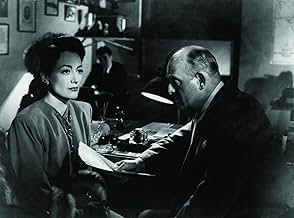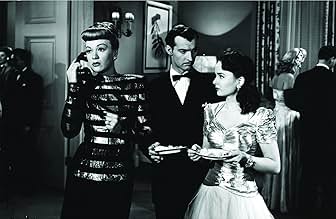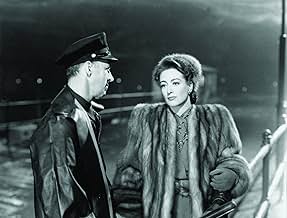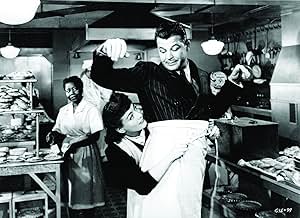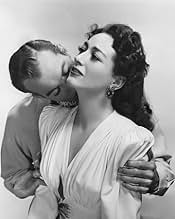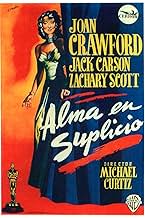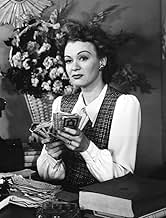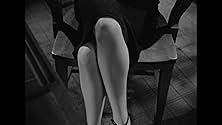AVALIAÇÃO DA IMDb
7,9/10
30 mil
SUA AVALIAÇÃO
Principal suspeita da morte do marido, Mildred Pierce conta o seu passado num depoimento policial. Do primeiro casamento ao relacionamento com as filhas e à forma como enriqueceu, revela o s... Ler tudoPrincipal suspeita da morte do marido, Mildred Pierce conta o seu passado num depoimento policial. Do primeiro casamento ao relacionamento com as filhas e à forma como enriqueceu, revela o suplício pelo que passou.Principal suspeita da morte do marido, Mildred Pierce conta o seu passado num depoimento policial. Do primeiro casamento ao relacionamento com as filhas e à forma como enriqueceu, revela o suplício pelo que passou.
- Direção
- Roteiristas
- Artistas
- Ganhou 1 Oscar
- 3 vitórias e 7 indicações no total
Bill Alcorn
- Soldier
- (não creditado)
Betty Alexander
- Party Guest
- (não creditado)
Ramsay Ames
- Party Guest
- (não creditado)
George Anderson
- Peterson's Assistant
- (não creditado)
James Anderson
- Diner Customer
- (não creditado)
Robert Arthur
- High School Boy
- (não creditado)
Lynn Baggett
- Waitress
- (não creditado)
Leah Baird
- Police Matron
- (não creditado)
Resumo
Reviewers say 'Mildred Pierce' is acclaimed for its strong female lead, complex dynamics, and themes of maternal love and social class. Joan Crawford's Oscar-winning performance is celebrated, and the film's noir elements are noted. However, some find the pacing slow and melodrama excessive, with Veda's character criticized. Despite this, it's seen as a classic with significant historical portrayal of women's roles.
Avaliações em destaque
James M Cain's novel 'Mildred Pierce' was much tougher, dirtier, violent and cynical than the gorgeously mounted movie it became, but the film still manages to maintain enough of the flavor of the book to be interesting. The portrait of working class life in Southern California works well, as does the depiction of a marriage that breaks down because of disappointment and resentment rather than anything melodramatic. Within its first hour MILDRED PIERCE captures something anxious about American life and marriages and families that is more true than most of what movies had shown up to that time, and it would prove to be even more so in the postwar world to come. The movie actually becomes more false and synthetic as it moves into Mildred's rise in life, but by then the plot and characters have taken hold.
And so has the film's increasingly bleak look at what women can expect when they live and work alone in a man's world, beset by men who want to exploit them, sexually and otherwise. This too, though softened from the book, would have seemed refreshingly frank to many of viewers at that time.
What raises the film to the level of classic is the first class work from every professional in every department. Joan Crawford is not much more expressive here than she was in her later MGM pictures, but this character suits her limited talents so well that she seems better than in almost anything else she did. All her Warners pictures used her more effectively than MGM usually managed to do, perhaps because in them she is invariably exploited, abused, maligned, even tortured. The bad behavior her Warners characters inspire in others is so extreme that she doesn't need to be. These plots do what Adrian's sometimes garish clothes did for her at MGM: they give her a personality, make her seem more interesting than she really was, and they make her sympathetic despite her essential coldness. Crawford gets able support from Ann Blyth, Eve Arden (as comedy relief; she is almost appearing in another movie entirely), Zachary Scott and especially Jack Carson, dead-on as a sweaty hustler and low rent lothario, bringing nuance to what could have been a one-note portrayal. Bruce Bennett isn't really a good actor in the role of Mildred's first husband, but he's perfectly cast -- he looks like an Okie from one of Dorothea Lange's photographs who went west to 'make it' and never did.
And as has been frequently mentioned here, Ernest Haller's cinematography (especially in the brilliant prints now being shown on cable) is consistently evocative and beautiful. So many of his shots live in the memory: in the scene where a mink wearing, gun wielding Mildred comes upon Monte and Vida kissing, the image is an almost primal one of betrayal and glamor -- the way their profiles are in darkness, the way Ann Blyth arches back against the bar, the hard, dim glitter of lame and the billows of tulle from her gown. The way Vida tumbles forward into almost blinding lamplight while Monte's face hardens behind her -- these are the kinds of wonderful images the best old films regularly delivered. Also excellent is Anton Grot's art direction, opulent but still managing to help create the particular SoCal atmosphere of this picture. And as usual, Max Steiner's score is effective, but as an earlier poster noted, he recycled a couple of motifs from his Oscar-winning score to NOW, VOYAGER. And director Michael Curtiz must be praised for keeping everything in perfect balance. This is one of the most admired '40s pictures and well worth a look.
And so has the film's increasingly bleak look at what women can expect when they live and work alone in a man's world, beset by men who want to exploit them, sexually and otherwise. This too, though softened from the book, would have seemed refreshingly frank to many of viewers at that time.
What raises the film to the level of classic is the first class work from every professional in every department. Joan Crawford is not much more expressive here than she was in her later MGM pictures, but this character suits her limited talents so well that she seems better than in almost anything else she did. All her Warners pictures used her more effectively than MGM usually managed to do, perhaps because in them she is invariably exploited, abused, maligned, even tortured. The bad behavior her Warners characters inspire in others is so extreme that she doesn't need to be. These plots do what Adrian's sometimes garish clothes did for her at MGM: they give her a personality, make her seem more interesting than she really was, and they make her sympathetic despite her essential coldness. Crawford gets able support from Ann Blyth, Eve Arden (as comedy relief; she is almost appearing in another movie entirely), Zachary Scott and especially Jack Carson, dead-on as a sweaty hustler and low rent lothario, bringing nuance to what could have been a one-note portrayal. Bruce Bennett isn't really a good actor in the role of Mildred's first husband, but he's perfectly cast -- he looks like an Okie from one of Dorothea Lange's photographs who went west to 'make it' and never did.
And as has been frequently mentioned here, Ernest Haller's cinematography (especially in the brilliant prints now being shown on cable) is consistently evocative and beautiful. So many of his shots live in the memory: in the scene where a mink wearing, gun wielding Mildred comes upon Monte and Vida kissing, the image is an almost primal one of betrayal and glamor -- the way their profiles are in darkness, the way Ann Blyth arches back against the bar, the hard, dim glitter of lame and the billows of tulle from her gown. The way Vida tumbles forward into almost blinding lamplight while Monte's face hardens behind her -- these are the kinds of wonderful images the best old films regularly delivered. Also excellent is Anton Grot's art direction, opulent but still managing to help create the particular SoCal atmosphere of this picture. And as usual, Max Steiner's score is effective, but as an earlier poster noted, he recycled a couple of motifs from his Oscar-winning score to NOW, VOYAGER. And director Michael Curtiz must be praised for keeping everything in perfect balance. This is one of the most admired '40s pictures and well worth a look.
Joan Crawford, one of the world's great movie stars, truly shines in "Mildred Pierce", a tense, prickly film noir full of suspense and drama!
Joan is Mildred, a hard working pie and chicken maven who becomes a successful restuaranteur. Ann Blyth is superb as her nasty daughter Veda, who stoops to every level to get what she wants. Eve Arden and Jack Carson are unstoppable as Mildred's friends. "Mildred Pierce" was directed by the famed Michael Curtiz, best known for his work in "Casablanca". But it is my opinion that his best work is "Mildred Pierce". The lighting, the costumes, the sets, and most importantly, the writing all help this gem of a film become a true classic.
Joan won an Oscar for her breathtaking performance, but the tour de force powerhouse in "Mildred Pierce" was Ann Blyth. Black hearted Veda was the lynch pin of this movie, and Blyth's portrayal made Veda seem all too real and frightening. Nominated for an Oscar, she should have won.
Don't miss this timeless nail-biter
Joan is Mildred, a hard working pie and chicken maven who becomes a successful restuaranteur. Ann Blyth is superb as her nasty daughter Veda, who stoops to every level to get what she wants. Eve Arden and Jack Carson are unstoppable as Mildred's friends. "Mildred Pierce" was directed by the famed Michael Curtiz, best known for his work in "Casablanca". But it is my opinion that his best work is "Mildred Pierce". The lighting, the costumes, the sets, and most importantly, the writing all help this gem of a film become a true classic.
Joan won an Oscar for her breathtaking performance, but the tour de force powerhouse in "Mildred Pierce" was Ann Blyth. Black hearted Veda was the lynch pin of this movie, and Blyth's portrayal made Veda seem all too real and frightening. Nominated for an Oscar, she should have won.
Don't miss this timeless nail-biter
The characterization of film noire is applied to certain films that touch on the grittier, more cynical aspects of life. This genre is typified as having lead roles played by strong, solemn male characters, in this respect, Mildred Pierce is an exception. In all other ways Mildred Pierce follows the model for a great film noire. The main character encounters both success and crushing emotional hardships, which the viewer gets to see the effects of. The supporting characters do a wonderful job depicting deceit in action, and each individual character contributes moving specific parts of the film along. The film ends with somewhat of an untied knot, and the viewer could certainly learn to love Mildred as the epitome of a "tragic hero". The film starts with a mystery and works it's way backwards, and as you can assume the viewer imagines he/she knows what is going on, when clearly the writer has us at his whims. Great acting. Great tragedy. Great film noire.
Six shots fired and a man falls down dead. Shortly thereafter, we meet a desperate Mildred Pierce who walks along the streets of the night. After a policeman prevented her from jumping into the river, she ends up at a bar where an old acquaintance flirts uncontrollably. They go to her house on the beach, from Mildred suddenly quickly departs. It turns out that it was in this house that the man was shot and soon the police on the spot. During interrogation begins the story of what led up to that fateful night. Mildred tells how she differs from her husband, working upward as a business woman and how she is willing to do absolutely everything to their already spoiled daughter Veda.
Mildred Pierce literally sparkles. Director Michael Curtiz, probably best known for Casablanca, knows how to get the luxurious feel of a grand noir drama. Elegant small transitions, meticulous and dramatic lighting applications, all in classic Hollywood manner, where nothing is left to chance.
The dialog is fabulous. Mildred's right hand Ida is so cool, with the hatching of witty one-liners. Even the ever-swarming Wally Fay is constantly exciting to listen to.
The story in itself is exciting, where you always know roughly how it will end, but not why or what role some of the characters will play. The characters are the driving force. It's about Mildred's efforts to give their daughters the life she had wanted, although it also means she does not listen to what they really want. Then there is a former spouse who is living his new life in the periphery, the friend who is helpful, but not without being sure to reap the rewards of Mildred's success and even a new one that might not be what he appears to be.
Crawford got a well-deserved Oscar for this film.
Mildred Pierce literally sparkles. Director Michael Curtiz, probably best known for Casablanca, knows how to get the luxurious feel of a grand noir drama. Elegant small transitions, meticulous and dramatic lighting applications, all in classic Hollywood manner, where nothing is left to chance.
The dialog is fabulous. Mildred's right hand Ida is so cool, with the hatching of witty one-liners. Even the ever-swarming Wally Fay is constantly exciting to listen to.
The story in itself is exciting, where you always know roughly how it will end, but not why or what role some of the characters will play. The characters are the driving force. It's about Mildred's efforts to give their daughters the life she had wanted, although it also means she does not listen to what they really want. Then there is a former spouse who is living his new life in the periphery, the friend who is helpful, but not without being sure to reap the rewards of Mildred's success and even a new one that might not be what he appears to be.
Crawford got a well-deserved Oscar for this film.
Joan Crawford plays the title role, a mother who will do anything for her selfish daughter Veda, played by Ann Blyth. Mildred even goes into business, becoming a successful restaurant owner, but Veda is still ungrateful even as her mother has provided her opportunities in society.
Jack Carson plays Wally Fay, a man Mildred manipulates; Zachary Scott is Monte Beragon, another who gets involved in a tragic love triangle of sorts with Crawford's and Blyth's characters. Eve Arden plays Ida Corwin, a friend of Mildred's who later becomes one of her employees, that gets to say some great sassy lines including "Personally, Veda's convinced me that alligators have the right idea. They eat their young."
Eventually, the daughter gets herself in deep trouble and the mother's sacrifice is made even greater. Directed by Michael Curtiz, and based on the James M. Cain novel with a screenplay by Ranald MacDougall, this essential drama also features Bruce Bennett, Lee Patrick, Veda Ann Borg, and Butterfly McQueen (uncredited).
Joan Crawford's Academy Award winning Best Actress performance on her first (!) of three nominations. Also Supporting Actress Oscar nominations for Arden (her only!) and Blyth (her only as well). The film, its B&W Cinematography, and MacDougall's (his only) screenplay were also nominated. Added to the National Film Registry in 1996.
Jack Carson plays Wally Fay, a man Mildred manipulates; Zachary Scott is Monte Beragon, another who gets involved in a tragic love triangle of sorts with Crawford's and Blyth's characters. Eve Arden plays Ida Corwin, a friend of Mildred's who later becomes one of her employees, that gets to say some great sassy lines including "Personally, Veda's convinced me that alligators have the right idea. They eat their young."
Eventually, the daughter gets herself in deep trouble and the mother's sacrifice is made even greater. Directed by Michael Curtiz, and based on the James M. Cain novel with a screenplay by Ranald MacDougall, this essential drama also features Bruce Bennett, Lee Patrick, Veda Ann Borg, and Butterfly McQueen (uncredited).
Joan Crawford's Academy Award winning Best Actress performance on her first (!) of three nominations. Also Supporting Actress Oscar nominations for Arden (her only!) and Blyth (her only as well). The film, its B&W Cinematography, and MacDougall's (his only) screenplay were also nominated. Added to the National Film Registry in 1996.
Você sabia?
- CuriosidadesAfter seeing the film, James M. Cain sent Joan Crawford a signed first edition of the original novel. The inscription read: "To Joan Crawford, who brought Mildred Pierce to life just as I had always hoped she would be, and who has my lifelong gratitude."
- Erros de gravaçãoMildred's house on Corvallis Street in Glendale is shown as a one-story Spanish-style bungalow; however, the interior has a staircase leading to the bedrooms.
- Citações
Ida Corwin: [to Wally about his lustful looks in her direction] Leave something on me. I might catch cold.
- Cenas durante ou pós-créditosThe opening credits are presented with a background ocean scene that "washes" the credits on the screen.
- Versões alternativasAlso shown in computer colorized version.
- ConexõesFeatured in Hollywood: The Fabulous Era (1962)
- Trilhas sonorasYou Must Have Been a Beautiful Baby
(uncredited)
Music by Harry Warren
Lyrics by Johnny Mercer
Played and sung at Wally's club toward the beginning
Also played when Veda and Ted are at Wally's club
Principais escolhas
Faça login para avaliar e ver a lista de recomendações personalizadas
- How long is Mildred Pierce?Fornecido pela Alexa
Detalhes
- Data de lançamento
- País de origem
- Idiomas
- Também conhecido como
- El suplicio de una madre
- Locações de filme
- Empresa de produção
- Consulte mais créditos da empresa na IMDbPro
Bilheteria
- Orçamento
- US$ 1.453.000 (estimativa)
- Faturamento bruto mundial
- US$ 11.751
- Tempo de duração
- 1 h 51 min(111 min)
- Cor
- Proporção
- 1.37 : 1
Contribua para esta página
Sugerir uma alteração ou adicionar conteúdo ausente




